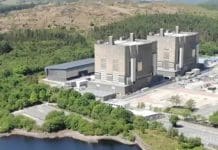An innovative district heating network project aims to dig deep to power Stoke-on-Trent’s economic renaissance. Andy Platt, Cabinet Member for Green Enterprise at Stoke-on-Trent City Council outlines the project and its benefits.
The whole of the UK faces a mounting challenge to protect consumers from the ravages of a volatile energy market while simultaneously increasing the use of renewable power and cutting carbon emissions. Stoke-on-Trent’s circumstances are no different.
It would be easy to argue that, having invested tens of millions of pounds in retrofit energy saving improvements for local homes in recent years, as well as supporting the creation of the multi-million pound Centre of Refurbishment Excellence in the city, the council has done all that it could to meet this challenge – particularly at a time when financial constraints pose a threat to our core services. But we are determined to go much further than this and bring to fruition our own unique vision for localised energy security.
The scale and urgency of the escalating energy price challenge have forced us to look in greater detail at how the city’s energy needs are likely to shape our communities and our economy. Stoke-on-Trent has traditionally been home to some of the UK’s most energy-intensive industries, and although the commercial landscape has changed significantly in the last 30 years, reliance on plentiful energy is still an important economic consideration.
In the absence of clear national consensus, we have resolved to take matters into our own hands to shield vulnerable businesses and communities from the excesses of the energy market. Faced with an increasingly stark choice between capitulation and innovation, we opted for the latter.
Surveys indicate that Stoke-on-Trent is situated about two kilometres above a naturally occurring source of geothermal energy, enabling us to tap into heat from within the Earth’s crust to warm buildings on the surface.
We are confident that, with financial support from the Department for Energy and Climate Change, we will be able to tap into this abundant renewable energy source, pump it to the surface and distribute the heat direct to the city’s university and further education colleges, commercial and business premises, council-owned buildings and homes.
According to our projections, from 2018 locally produced geothermal energy will supply heat at a predictable, attractive price on an 11 kilometre network spanning the city centre, the Etruria Valley business park, the University Quarter and Stoke town.
The availability of up to 45 gigawatt hours of renewable energy will cut Stoke-on-Trent’s carbon emissions by an estimated 12,000 tonnes a year. But more importantly, it will also offer unparalleled energy price stability, removing much of the uncertainty which continues to dog the wider domestic energy market.
Earlier this year, our vision for local energy security took a huge leap forward when the city council, along with our partners in Staffordshire County Council and the Stoke-on-Trent and Staffordshire Local Enterprise Partnership, signed a momentous city deal with the government worth about £113m over the next 10 years. The centrepiece of this deal was a £20m government funding pledge towards the £52m cost of creating the District Heat Network.
The early instalments of this financial support are already trickling down from Whitehall, enabling us to focus on strengthening our business case so that we can put our proposal to the market in order to line up potential commercial partners with the necessary expertise. This partnership approach will enable us to access and extract the subterranean hot water and, by means of a heat exchanger, use it to energise a district heat network that will serve buildings in the public and private sector.
There are still many steps to go through in the process of getting the District Heat Network up and running, and every groundbreaking infrastructure project encounters its fair share of challenges on the journey from concept to completion. However, it is heartening to note that Stoke-on-Trent secured the second largest injection of government funds out of the 20 wave two cities – particularly considering that bids were assessed against their feasibility and commercial viability, as well as expected environmental and social benefits.
We believe that our proposal has the potential to transform our city’s economic prospects and help to accelerate Stoke-on-Trent’s renaissance as an emerging national hub for renewable energy research and innovation. What is becoming increasingly clear is that ministers share our view and are responding to the city council’s growing confidence in its regeneration strategy.
The District Heat Network is about far more than securing short-term energy price stability. The success of this unique project will send a clear signal to potential investors, central government and regional drivers of growth that Stoke-on-Trent is an innovative city with the focus, the leadership and the will to take control of its own destiny and claim its rightful place as a future economic powerhouse.
Andy Platt
Cabinet Member for Green Enterprise
Stoke-on-Trent City Council
Tel: 01782 234234
www.twitter.com/SoTCityCouncil














